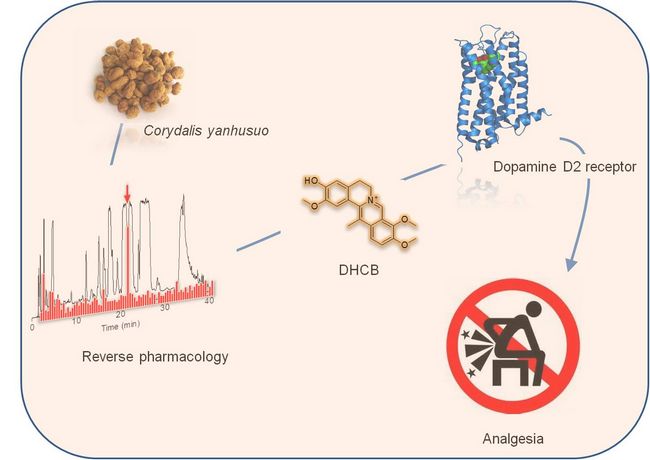大连化物所在延胡索中分离出一种新止痛有效成分:去氢紫堇球碱
近日,中科院大连化学物理研究所梁鑫淼研究员领导的液相色谱分离材料研究组(1803组)与美国加州大学欧文分校Civelli教授领导的药理学团队合作,在传统镇痛中药延胡索中发现了一种新的止痛有效成分——去氢紫堇球碱(dehydrocorybulbine,DHCB)。相关文章发表于2014年1月2日的《Current BioLogy》杂志上。

大连化物所在延胡索中分离出一种新止痛有效成分:去氢紫堇球碱
该项研究旨在利用现代高效分离技术,结合高通量高内涵的活性筛选,对传统中药中的物质基础和有效成分进行深入剖析和挖掘,以期提升对中药的整体认识,并发现有潜力的先导化合物进行新药开发。
在此次合作研究中,两国科学家聚焦于镇痛活性成分的发现。研究者首先采用高效液相色谱分离技术将十种知名镇痛中药制备成500个标准组分,通过系统活性筛选,最终将目标锁定在了延胡索的一个组分上。经过进一步的纯化分离和结构鉴定,确认其中的活性化合物为DHCB。并以小檗碱为原料,实现了DHCB的化学半合成。动物实验表明,DHCB对急性疼痛、炎症性疼痛和神经性疼痛都有显著的缓解作用,虽然在镇痛效果不如吗啡,但在作用持续时间以及耐药性上,DHCB都要明显优于吗啡。此外,研究者还发现,DHCB的作用靶点并非阿片受体,而是与多巴胺D2受体相关,这将大大降低该化合物的成瘾风险。因此DHCB对于低水平、持续性的慢性疼痛可能具有较好的治疗前景。而慢性疼痛,特别是神经性慢性疼痛,临床尚缺乏有效治疗手段,从而往往导致患者滥用止痛药。DHCB的发现,为此类疼痛问题的治疗带来新的希望。
以上研究得到了中国国家自然科学基金委、科技部国际合作等相关项目的资助。
原文摘要:
A Novel Analgesic Isolated from a Traditional Chinese Medicine
Yan Zhang,Chaoran Wang,Lien Wang,Gregory Scott Parks,Xiuli Zhang,Zhimou Guo,Yanxiong Ke,Kang-Wu Li,Mi Kyeong Kim,Benjamin Vo,Emiliana Borrelli,Guangbo Ge,Ling Yang,Zhiwei Wang,M. Julia Garcia-Fuster,Z. David Luo,Xinmiao Liang,Olivier Civelli
Background
Current pain management is limited, in particular, with regard to chronic pain. In an attempt to discover novel analgesics, we combined the approach developed to characterize traditional Chinese medicine (TCM), as part of the “herbalome” project, with the reverse pharmacology approach aimed at discovering new endogenous transmitters and hormones.
Results
In a plant used for centuries for its analgesic properties, we identify a compound, dehydrocorybulbine (DHCB), that is effective at alleviating thermally induced acute pain. We synthesize DHCB and show that it displays moderate dopamine receptor antagonist activities. By using selective pharmacological compounds and dopamine receptor knockout (KO) mice, we show that DHCB antinociceptive effect is primarily due to its interaction with D2 receptors, at least at low doses. We further show that DHCB is effective against inflammatory pain and injury-induced neuropathic pain and furthermore causes no antinociceptive tolerance.
Conclusions
Our study casts DHCB as a different type of analgesic compound and as a promising lead in pain management.

